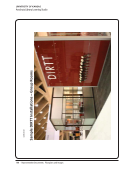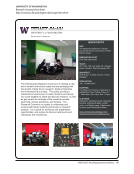SPEC Kit 327: Reconfiguring Service Delivery · 53
Still too new to assess.
The 24/7 space is included in assessment efforts such as surveys and focus groups which look at how well we are
meeting patron needs in the areas of service provision, services and equipment, and physical space.
The library vacated the space in the timeframe specified by the university. Soon after closing, user complaints were
virtually non-existent.
The new configuration should meet the information needs of patrons.
The reference librarians are able to answer the majority of government documents questions the government
documents librarian will be able to continue providing government documents instruction the department has several
librarians trained to handle more difficult and complex research.
Use: data indicate significant increase in gate count at this service point. Time on task: data indicate that students
who use the Research Commons spend significantly more time in the library than students who use other areas.
Collaboration: increased collaboration with Graduate School &Undergraduate Academic Affairs in support of student
success at all levels.
User and staff feedback and assessment. Salary savings.
User and staff satisfaction.
User feedback, staff savings, user engagement with facility.
User satisfaction. Use of services. Contribution to library-wide discussion of services.
User satisfaction and ability to access and use the Media/Microforms collections. Reduced operating expenditures/
greater efficiency.
User satisfaction. Number of complaints.
User surveys.
Users are asked to rate satisfaction and importance of various library services in the annual library survey the responses
can be tied to particular libraries. Classes rate satisfaction with instruction on evaluations. One-on-one consultations are
also rated.
We are comparing our LibQUAL+® data from 2011 to previous years to assess our service delivery reconfiguration. We
will conduct additional surveys/focus groups as needed based on what we learn from LibQUAL+® data.
We are in our first year of using a Balanced Scorecard model for assessment. Each department developed objectives,
targets, and measures. Many of these assessment goals were focused on determining changes to service quality or
benchmarking the needs of the community.
We have not yet conducted a formal assessment but the anecdotal evidence in terms of support from faculty and
students and much positive feedback tells us that the new department was well received.
We participate in LibQUAL+® so some comments from that survey may address the consolidation.
We will examine statistics and data related to these services, feedback from service providers received during listening
sessions, and feedback from chat users via the online survey. We are still determining other mechanisms for gathering
additional feedback from our users.
Still too new to assess.
The 24/7 space is included in assessment efforts such as surveys and focus groups which look at how well we are
meeting patron needs in the areas of service provision, services and equipment, and physical space.
The library vacated the space in the timeframe specified by the university. Soon after closing, user complaints were
virtually non-existent.
The new configuration should meet the information needs of patrons.
The reference librarians are able to answer the majority of government documents questions the government
documents librarian will be able to continue providing government documents instruction the department has several
librarians trained to handle more difficult and complex research.
Use: data indicate significant increase in gate count at this service point. Time on task: data indicate that students
who use the Research Commons spend significantly more time in the library than students who use other areas.
Collaboration: increased collaboration with Graduate School &Undergraduate Academic Affairs in support of student
success at all levels.
User and staff feedback and assessment. Salary savings.
User and staff satisfaction.
User feedback, staff savings, user engagement with facility.
User satisfaction. Use of services. Contribution to library-wide discussion of services.
User satisfaction and ability to access and use the Media/Microforms collections. Reduced operating expenditures/
greater efficiency.
User satisfaction. Number of complaints.
User surveys.
Users are asked to rate satisfaction and importance of various library services in the annual library survey the responses
can be tied to particular libraries. Classes rate satisfaction with instruction on evaluations. One-on-one consultations are
also rated.
We are comparing our LibQUAL+® data from 2011 to previous years to assess our service delivery reconfiguration. We
will conduct additional surveys/focus groups as needed based on what we learn from LibQUAL+® data.
We are in our first year of using a Balanced Scorecard model for assessment. Each department developed objectives,
targets, and measures. Many of these assessment goals were focused on determining changes to service quality or
benchmarking the needs of the community.
We have not yet conducted a formal assessment but the anecdotal evidence in terms of support from faculty and
students and much positive feedback tells us that the new department was well received.
We participate in LibQUAL+® so some comments from that survey may address the consolidation.
We will examine statistics and data related to these services, feedback from service providers received during listening
sessions, and feedback from chat users via the online survey. We are still determining other mechanisms for gathering
additional feedback from our users.






















































































































































































































